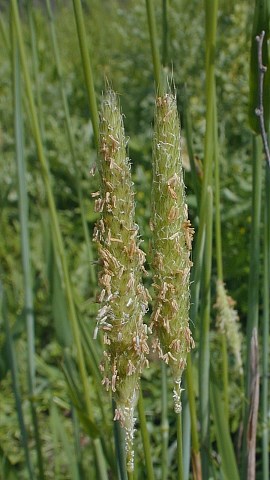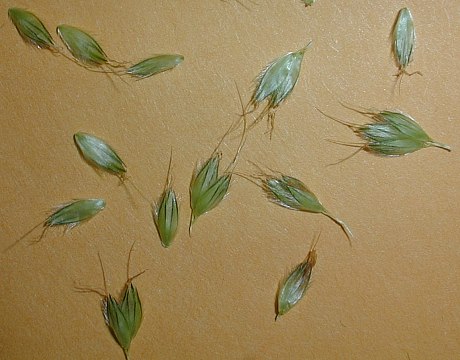Description: This perennial grass is 1-3' tall. The light to medium green culms are unbranched, terete, hairless, and hollow; they are stiffly erect. Each fertile culm has about 4 alternate leaves along the lower two-thirds of its length. The leaf blades are up to 10" long and 10 mm. across, becoming smaller as they ascend the culm. Lower blades are widely spreading, while upper blades are more ascending; they are medium dull green, flat, and minutely sawtoothed along their margins. The leaf blades lack conspicuous hairs, although rows of minute appressed hairs can be observed on their lower surfaces with 10x magnification. The hairless sheaths are dull green or blue-green, longitudinally veined, and slightly loose or inflated. The ligules are membranous, while the nodes are swollen and glabrous.

Each culm
terminates in a spike-like panicle about 1½–3½" long and ¼" across (or
slightly wider). This inflorescence is narrowly cylindrical in shape,
soft-textured, and light green (except for the abundant anthers). The
ascending spikelets often occur in pairs on short slender pedicels
about 1-3 mm. long. Each spikelet consists of a pair of glumes and a
single lemma with a perfect floret; disarticulation is below the
glumes. The glumes are 4-6 mm. long, sharply keeled, and joined
together at the base; there are silky hairs along their keels. Each
side of a glume is elliptic-lanceolate in shape. The lemma is 4-6 mm.
long and sharply keeled; each side of the lemma is elliptic or narrowly
ovate in shape. Each lemma has an awn about 6-10 mm. long; it is joined
to the lemma near the base. The blooming period occurs during the late
spring; at this time, the large anthers are cream-colored, while the
feathery styles are white. Later, the anthers become light brown. Each
lemma contains a small grain. The root system is fibrous and
rhizomatous. This grass forms a loose turf from its rhizomes.
Cultivation:
The preference is full sun and moist to mesic conditions. This grass
adapts to loam or clay-loam, and probably other kinds of soil as well.
Most growth and development occurs during the spring. This cool-season
grass has a C3 metabolism.

Range &
Habitat:
The non-native Meadow Foxtail is uncommon in Illinois; it has
naturalized in the NE
section of the state and scattered counties elsewhere (see Distribution
Map). This species is native to Eurasia. Habitats include
fields, areas along railroads, and the margins of seasonal wetlands
where there is little flooding. Meadow Foxtail may become more common
in Illinois in the future; it is found in habitats with a history of
disturbance.
Faunal Associations:
This grass is palatable to cattle, horses, and other hoofed mammalian
herbivores; it is sometimes planted in pastures as a source of forage.
Insects that feed on either the foliage or roots of Meadow Foxtail
include Oulema melanopus
(Cereal Leaf Beetle), Rhopalosiphum
maidis (Corn Leaf Aphid), Rhopalosiphum padi
(Bird Cherry & Oat Aphid), Schizaphis
graminum (Greenbug), and Sitobion avenae
(English Grain Aphid); see Clark et al. (2004), Robinson &
Bradley (1965). Larvae of Clinodiplosis
setariae (Grass Seed Midge) feed on Alopecurus spp. and
other grasses (Felt, 1917).
Photographic Location:
Along a seasonal wetland in Judge Webber Park near Urbana, Illinois.

Comments: This grass closely resembles the more common Phleum pratense (Timothy). However, Meadow Foxtail blooms a few weeks earlier than Timothy and its cylindrical inflorescence has a silky-smooth texture; the inflorescence of Timothy is more firm and rough to the touch. Furthermore, the spikelets of these two grasses, when they are examined individually, are very different from each other in appearance. Meadow Foxtail is also distinct from the weedy Setaria spp. (Bristlegrasses); like Alopecurus spp., Setaria spp. are often referred to as 'Foxtail grasses.' These latter grasses have cylindrical inflorescences that feel squiggly when they are rolled between the fingers, and they often nod to a greater or lesser degree (depending on the species). Bristlegrass usually has multiple awn-like hairs that originate from the bottom of each spikelet, while each spikelet of Meadow Foxtail (and other Alopecurus spp.) has a single awn that originates from the lemma. There are other Alopecurus spp. (Foxtail Grasses) in Illinois (both native and introduced), but they have shorter glumes and lemmas (less than 4 mm. in length).